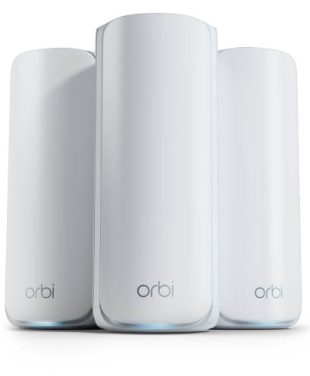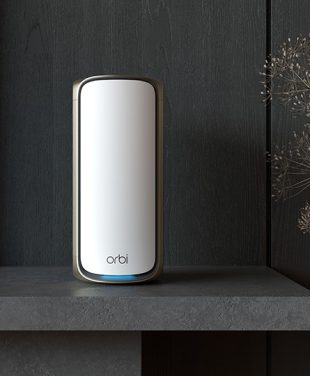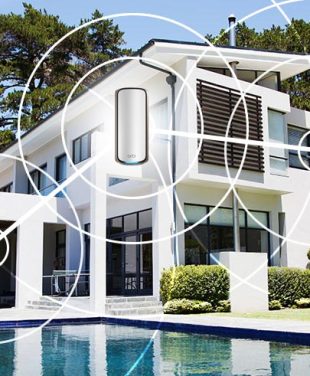HOW IS WIFI 7 DIFFERENT FROM WIFI 6/6E?
WiFi 7 offers benefits that are a quantum leap forward from WiFi 6 and WiFi 6E. With its faster speeds, lower latency, and significant capacity increases, WiFi 7 the new wireless standard is a major evolution of WiFi 6 and 6E, bears much in common with those earlier standards but with some significant improvements to meet our growing requirements. What has changed, what is still the same, and when should you upgrade? Let’s have a look.
 |
What’s new in the WiFI 7 Standard?
- 46Gbps – 4.8X FASTER SPEED
- Up to 2.4x Faster for the same WiFi configuration
- 320MHz – 2X BANDWIDTH
- 4096 QAM – X DATA DENSITY
Faster speeds
Most exciting and noteworthy, WiFi 7 will be much faster than WiFi 6. For the same WiFi radio configuration, the speeds will be 2.4x faster. So, maximum speeds with a typical mobile phone with WiFi 7 can reach up to 5Gbps. As the Internet speed offered by internet service providers (ISPs) continues to grow, WiFi 7 helps to ensure your home is ready for 10 Gigabit internet speeds as they become available.
But what makes these incredible speeds possible? They’re due to the next two major upgrades.
Greater channel width
Each WiFi band operates in smaller bands of 20/40/80/160MHz MHz for connecting to individual devices. WiFi 7 doubles the bandwidth to 320MHz. Effectively, this doubles the WIFi speeds to individual devices and adds a lot more bandwidth to support more devices.
More data density
WiFi 7 increases not only speed and bandwidth but also the amount of data that can be encoded onto a radio signal. This is measured by a standard known as quadrature amplitude modulation (QAM). Where WiFi 6’s QAM limit was 1024, WiFi 7 offers an impressive 4096 (or 4K; the standard is also known as 4K QAM), boosting its peak rates to increase throughput. Each symbol transmitted can now carry 12 bits rather than 10 bits, meaning 20% higher theoretical transmission rates.
Both the greater channel bandwidth (320MHz) and more data density (4K QAM) account for the 2.4x improvement in WiFi speeds between WiFi 6 and WiFi 7.
Other significant Improvements in WiFi 7
Multi-Link Operation (MLO)
Currently routers can support multiple WiFi bands- 2.4, 5 & 6GHz, but WiFi clients connect using one of the WiFi bands. With WiFi 7, routers will be able to connect across two different bands to a client device.
Imagine two highways leading to your destination. MLO is similar to giving these highways the flexibility to either spread the traffic across both routes or to quickly move traffic from one highway to another if one gets congested.
Mesh systems would especially benefit from MLO as it would allow for a router and a satellite both capable of transmitting simultaneously across two different bands to get the best performance. This feature will also be very useful for switching from one band to another on your mobile device without losing the connection. If you are on a Zoom call and walk from the center of the house to the backyard, WiFi 7 will allow your device to switch from 6GHz to 5GHz to 2.4GHz without dropping the call or buffering.
Flexible channel utilization
One key limitation with WiFi is that any kind of interference impacts the entire channel. With “puncturing,” if a portion of a channel gets impacted due to interference, that portion alone can be blocked while continuing to use rest of the channel for data transfer. This makes WiFi more resistant to interference and ensures critical flow and latency are not impacted. Going back to our highway example, using WiFi 6 a pothole in a lane can make that lane unusable, but with WiFi 7 you can block the pothole and drive around and still use rest of the lane.
What hasn’t changed?
- SAME THREE BANDS
- LIGHTNING-FAST SPEEDS
- MASSIVE BANDWIDTH
- LIMITED DEVICE SUPPORT
With WiFi 7’s incredible specs, it’s easy to overlook the fact that it builds on WiFi 6 & 6E features and infrastructure. As noted above, WiFi 6 and WiFi 7 both offer the same three bands, including the lightning-fast 6GHz band. Both feature tremendous bandwidth. And both WiFi 6E and WiFi 7 have technology providers still playing catch-up, with new devices being introduced to unlock the full potential of either standard. Even in the shadow of the forthcoming WiFi 7, WiFi 6E should still be considered a cutting-edge technology.
Should you upgrade to a WiFi 7 Router?
 WiFi 7 is definitely the future of wireless: at some point in the future, we will all be using WiFi 7 routers and devices. Until then, most users will still find their needs met by WiFi 6 and WiFi 6E networks, especially ones provided by proven, rock-solid routers and mesh systems such as our Orbi and Nighthawk devices.
WiFi 7 is definitely the future of wireless: at some point in the future, we will all be using WiFi 7 routers and devices. Until then, most users will still find their needs met by WiFi 6 and WiFi 6E networks, especially ones provided by proven, rock-solid routers and mesh systems such as our Orbi and Nighthawk devices.
One thing to consider is the kind of mobile device you carry. At present, Apple’s iPhone does not support WiFi 6E, so a WiFi 6 network will deliver peak performance to iPhone users. Those with the latest Windows laptop or Android phones, which support WiFi 6E, should consider upgrading to a WiFi 6E network if they haven’t already. Such a system will provide superb performance for years to come.
Buying a WiFi router is an investment in upgrading your home WiFi infrastructure so it’s ready not only for today’s devices but also for upcoming gear. If you’re planning to upgrade your phones or laptops in the next couple of years, these devices will most likely support the latest WiFi standard. So, it is highly recommended that to protect your investment and get a router or mesh system based on the latest WiFi technology.
As WiFi 7 begins to emerge in the next year, systems supporting its premium features will certainly start being introduced in the market. Demanding users who plan to future-proof their home network for the next couple of years should consider adopting WiFi 7 devices when they are available. Serious gamers will appreciate the standard’s low latency and quick responsiveness. Those who engage frequently in VR/AR for work or pleasure will benefit from WiFi 7’s incredible speeds and low latency. And those who always want the latest and greatest will enjoy knowing that their network will be ready to make the most of their future product purchases for quite a while.
Of course, the best experience on any of these WiFi 7 standards is with a NETGEAR router or mesh system. We have WiFi 7 offerings in both the Orbi and Nighthawk family designed with high standards for the best routers and mesh systems that offer unsurpassed speed, capacity and security in their categories.




